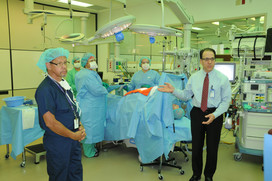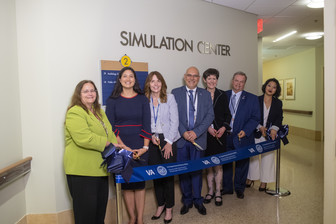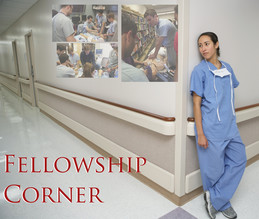|
|
|
|
 (Left to right) Rob Camp, intermediate care technician (ICT)/paramedic; Dustin Ament, ICT; and Jude Martinez, RN, cardiac cath lab, practice a REdI Mock Code scenario. (VA photo by Vanessa Aycock)
By Gerald Sonnenberg
EES Marketing and Communication
ORLANDO, Fla. – The Simulation Learning, Education and Research Network (SimLEARN) recently began providing mock code training specifically geared toward advanced cardiovascular life support (ACLS) and basic life support (BLS) staff. Utilizing SimLEARN’s Resuscitation Education Initiative (REdI) program, the REdI Mock Code Training Program (RMCTP) is accredited and implements a standardized methodology for mock code scenario development, evaluation and data collection, and helps establish uniform mock code training to equip facilities to deliver high-quality, high-impact training of their own.
The target audience for the 3-day course are ACLS and BLS instructors, and includes, but is not limited to, physicians and nurses. The training is held at local facilities with SimLEARN REdI staff traveling to the location to conduct the training. REdI also provides standardized tools to implement and evaluate the training at the local and the Veterans Integrated Service Network (VISN) level. SimLEARN REdI staff also provide standardized scenarios that have been vetted by experts for validity, online platform data collection and ongoing oversite of a facility’s RMCTP.
For the rest of the story, click here.
Back to top
|
|
|

By Gerald Sonnenberg
EES Marketing and Communication
ORLANDO, Fla. – The list of courses offered at the VHA SimLEARN National Simulation Center for the fourth quarter is below. For more information, check availability, or to enroll in the courses, please refer to the course catalog.
The following courses are scheduled to take place through September 2019:
- Trauma Nursing Core Course Instructor (TNCC) Sept. 16
- Trauma Nursing Core Course (TNCC) Sept. 17
- Introduction to Clinical Simulation (ICS) Sept. 10
- SimLEARN Faculty Instructor Course (SFIC) Sept. 24
- Maintenance of Certification of Anesthesia (MOCA) Sept. 6
- Out of Operating Room Airway Management (OOORAM) Sept. 10
If you have questions, please contact EES SimLEARN NSC Support EESSimLEARNNSCSupport@va.gov.
For more information about the SimLEARN program, please visit the SimLEARN website.
Back to top
|
|
|

By Anna Mechling
Public Affairs Intern
VA Pittsburgh Healthcare System
PITTSBURGH – VA Pittsburgh Healthcare System’s new state-of-the-art simulation center serves a critical role in improving Veterans health care.
“Simulation is for everyone,” said Dr. Lillian Emlet, interim education chief, during the center’s May 29 grand opening at the University Drive campus. “When we practice together, we perform better together.”
More than 80 staff, Veterans and visitors joined Emlet for the center’s public debut.
The simulation center is the latest update to VA Pittsburgh’s simulation-based training program. The $5.4 million center mimics the hospital’s clinical spaces, including an operating room and inpatient and outpatient procedure rooms. The 4,400 square-foot center provides staff with a safe place to practice hands-on health care procedures and communication skills.
For the rest of the story, click here.
In this image, officials, including Dr. Carolyn Clancy (third from right), Veterans Health Administration Deputy Under Secretary for Discovery, Education and Affiliate Networks, pose before cutting the ribbon on the new simulation center. (VA courtesy photo)
Back to top
|

By David Adriansen
VISN 23 Simulation Program Director
Minneapolis VA Health Care System
MINNEAPOLIS – Army Veteran Mark Gehrke had been missing his teeth for years, and his upper jaw had significant bone problems.
His dentist, Dr. Christopher French, an oral surgeon at the VA medical center in Minneapolis created a 3D printed model of his upper jaw to plan the surgical placement of four dental implants, using the model as a guide to plan the placement of the implants.
For this, Gehrke was thankful. “I appreciate getting the best care possible,” he said.
3D technology helps create guides for dental implant placement and medical models which aid in surgical planning. A digital capture is transferred to a 3D printer or dental mill to create the dental surgical guides or other products needed to support Veteran patient care.
For the rest of the story, click here.
In this image, (left) Dr. Christopher French, an oral surgeon at the Minneapolis VA Health Care System, shows Army Veteran Mark Gehrke a 3D printed model of his upper jaw to plan the surgical placement of four dental implants. (VA courtesy photo)
Back to top
|

By Bradley T. Eisenberg, PharmD, Simulation Fellow 2018-2019; Mary E. Holtschneider, RN-BC, MEd; and Chan W. Park, MD, FAAEM
Co-Directors, Durham VA Health Care System Interprofessional Advanced Fellowship in Clinical Simulation
Durham VA Health Care System
DURHAM, N.C. – The use of virtual patients to help train health care professionals has the potential to streamline educational efforts while still retaining many of the interactive benefits of using standardized patients. According to the Society for Simulation in Healthcare’s Simulation Dictionary (June 2016), virtual patient is defined as a representation of an actual patient. Virtual patients can take many forms such as software-based physiological simulators, simulated patients, physical mannequins and simulators (p. 40*). A virtual patient can be an effective way to bridge the gap between classroom learning and applying those acquired skills and knowledge in real-world patient encounters.
For the rest of the story, click here.
Back to top
|

By Kimberly A. Macasieb, MSN, RN, CNL, CNOR
Operating Room Staff Nurse
VA Southern Nevada Healthcare System
LAS VEGAS – Staff at the VA Southern Nevada Healthcare System (VASNHS) recently teamed up to create a realistic simulation designed for the post anesthesia care unit or PACU environment focusing on recognizing malignant hyperthermia (MH) signs and symptoms in a standardized patient. Training for MH emergencies is now in the VASNHS Operating room (OR) where staff began focusing on training for low-volume high-risk emergency situations such as MH by participating in a simulated MH crisis.
This training allows for hands-on practice, as well as to practice clinical procedures, communication and teamwork in a realistic, high-tension scenario.
For the rest of the story, click here.
In this image, (left to right) Marla Anderson, RN, and Kimberly Macasieb, RN, look on as Roma Polce, MD, administers simulated dantrolene to patient Lowen Patigayon (lying), while Mark Darcey, CRNA, ventilates the patient. (VA photo by Jennifer Bagwell)
Back to top
|

By Jorge Lara-Gutierrez, MD1
Simulation Fellow
VA Pittsburgh Healthcare System
PITTSBURGH – In September 2018, the VA Pittsburgh Simulation Center was asked to collaborate in the development of a simulation for the insertion of an esophageal tamponade balloon by members of the critical care service. This team included Lillian Emlet, MD; Bree Hansen, RN; and Holly Curinga, RN. The simulation planned would include training for multidisciplinary teams, attending physicians, fellows and nurses from the critical care units.
Variceal hemorrhage is an example of a medical emergency that requires effective care provided by a trained, rapid response team. To provide effective treatment and improve patient outcomes responding medical teams must simultaneously ensure hemodynamic stability, airway protection and management of the bleeding. The objective of this simulation was to provide education and hands-on preparation for responding to this low-volume, high-risk scenario and to identify gaps in care delivery.
For the rest of the story, click here.
Back to top
|
|
|
|
|
|
|